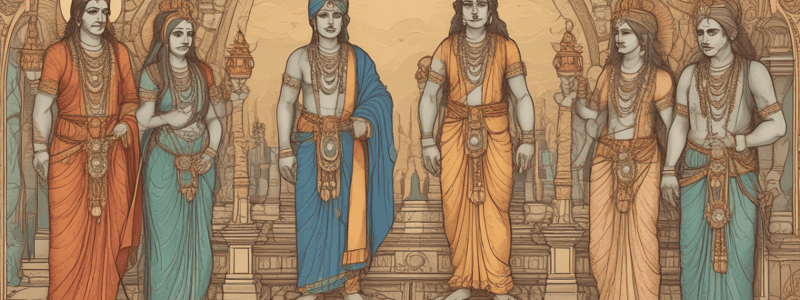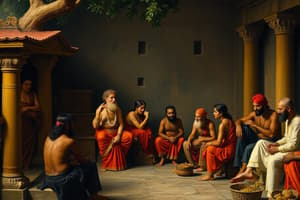Podcast
Questions and Answers
The prohibition of social interaction between different jatis is justified by the belief that contact with a lower jati can cause ritual impurity to a person of higher status.
The prohibition of social interaction between different jatis is justified by the belief that contact with a lower jati can cause ritual impurity to a person of higher status.
True (A)
The caste system was considered beneficial for social mobility.
The caste system was considered beneficial for social mobility.
False (B)
The practice of jati declined due to its effects on social mobility and occupational specialization.
The practice of jati declined due to its effects on social mobility and occupational specialization.
True (A)
The term "harijan" was used by Mahatma Gandhi to refer to people who were considered untouchable and excluded from society.
The term "harijan" was used by Mahatma Gandhi to refer to people who were considered untouchable and excluded from society.
The brahmins formulated laws to ensure the caste system's preservation by using religious texts to justify the social stratification and discourage attempts to change one's social class.
The brahmins formulated laws to ensure the caste system's preservation by using religious texts to justify the social stratification and discourage attempts to change one's social class.
Flashcards are hidden until you start studying
Study Notes
Origin of Caste System
- The word "caste" originated from the Portuguese word "casta," meaning "pure," introduced in the 16th century during Portuguese occupation in India.
- The Sanskrit word "varna," meaning "color," was used to refer to social stratification, which later evolved to mean "class" and eventually "caste."
Varnas in Hindu Society
- According to the Rig Veda, there are four classes in society:
- Brahmins (priests and sages) - the highest class
- Kshatriyas (warriors)
- Vaishyas (traders, bankers, farmers)
- Shudras (servants) - the lowest class
- The Hindu belief is that the cosmos follows a certain order, and the social system puts people in their proper places in society.
- The higher the social class, the closer one is to the gods, and the more purposeful their life is.
Jati System
- Jati, or birth groups/occupational groups, developed within the varna system over time.
- Preserving family occupation was the driving force behind the development of jati.
- Jati emphasized the hereditary nature of labor, making it a key factor in the multi-level and sub-caste system in rural India today.
Implementation of Caste System
- Brahmins created laws to implement the detailed caste system, including the prohibition of social interaction and marriage among different social classes.
- Socialization was limited to the same jati to avoid ritual impurity, especially for those with higher status.
Decline of Caste System
- The caste system declined due to its negative effects, including lack of social mobility and narrow occupational specialization.
- The practice was seen as an impediment to progress.
Social Implications
- The jati system led to the emergence of "untouchables" or dalits, who were excluded from society due to the nature of their work.
- Mahatma Gandhi referred to them as "harijan," meaning "children of God."
- The caste system resulted in an inflexible social stratification, determining one's social, economic, and religious future at birth.
Studying That Suits You
Use AI to generate personalized quizzes and flashcards to suit your learning preferences.




